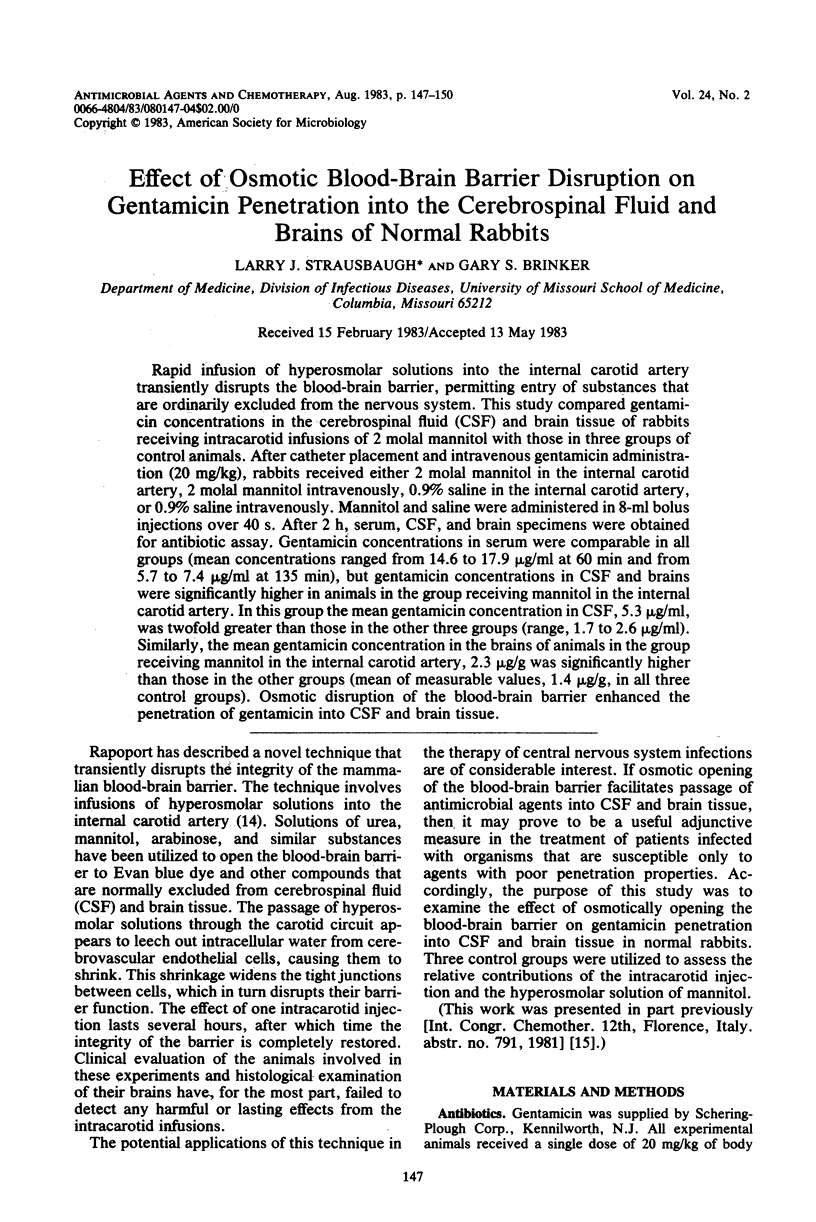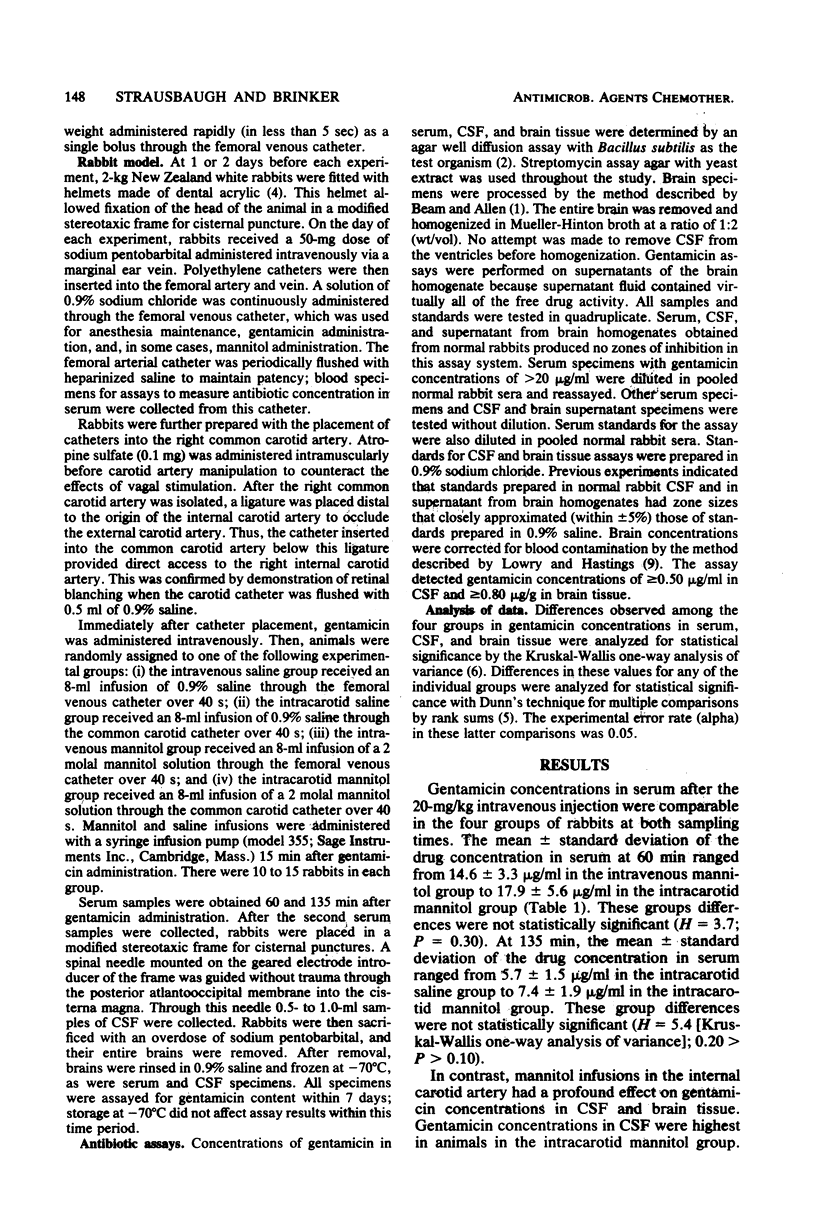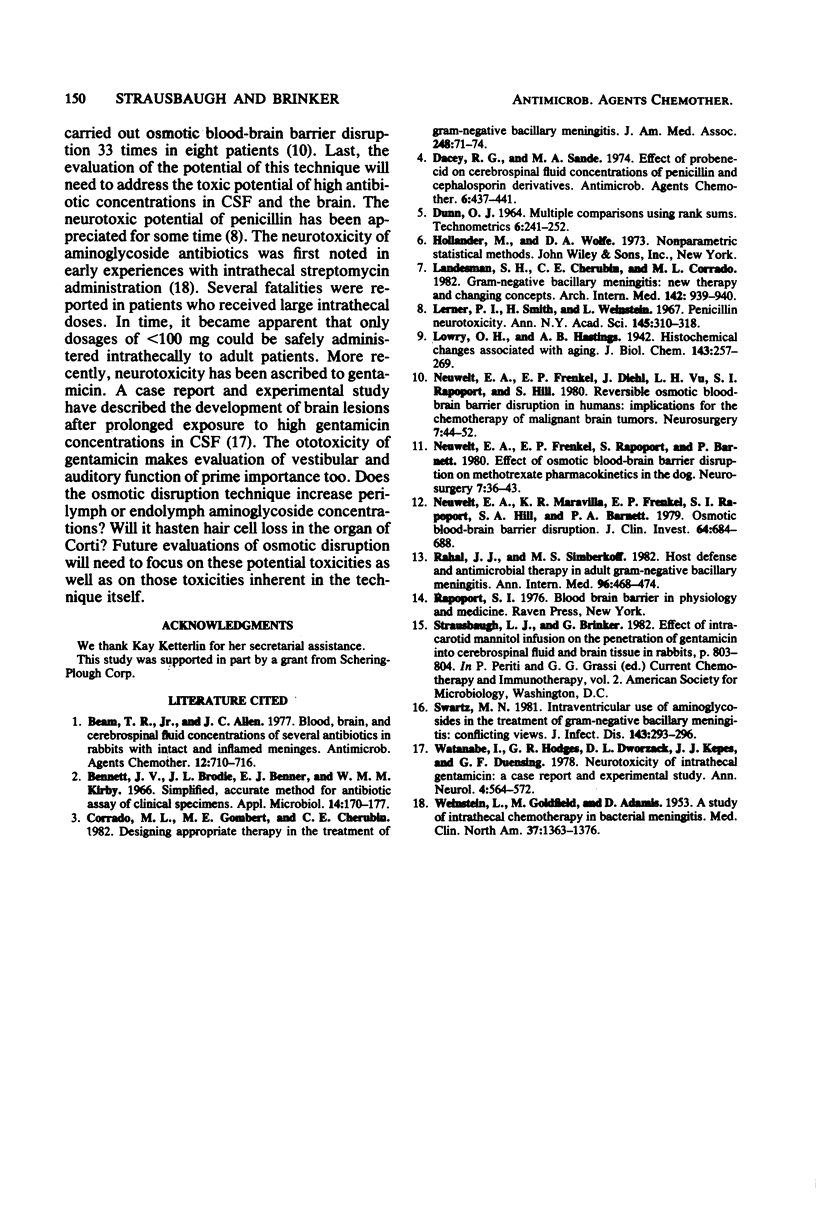Abstract
Rapid infusion of hyperosmolar solutions into the internal carotid artery transiently disrupts the blood-brain barrier, permitting entry of substances that are ordinarily excluded from the nervous system. This study compared gentamicin concentrations in the cerebrospinal fluid (CSF) and brain tissue of rabbits receiving intracarotid infusions of 2 molal mannitol with those in three groups of control animals. After catheter placement and intravenous gentamicin administration (20 mg/kg), rabbits received either 2 molal mannitol in the internal carotid artery, 2 molal mannitol intravenously, 0.9% saline in the internal carotid artery, or 0.9% saline intravenously. Mannitol and saline were administered in 8-ml bolus injections over 40 s. After 2 h, serum, CSF, and brain specimens were obtained for antibiotic assay. Gentamicin concentrations in serum were comparable in all groups (mean concentrations ranged from 14.6 to 17.9 micrograms/ml at 60 min and from 5.7 to 7.4 micrograms/ml at 135 min), but gentamicin concentrations in CSF and brains were significantly higher in animals in the group receiving mannitol in the internal carotid artery. In this group the mean gentamicin concentration in CSF, 5.3 micrograms/ml, was twofold greater than those in the other three groups (range, 1.7 to 2.6 micrograms/ml). Similarly, the mean gentamicin concentration in the brains of animals in the group receiving mannitol in the internal carotid artery, 2.3 micrograms/g was significantly higher than those in the other groups (mean of measurable values, 1.4 micrograms/g, in all three control groups). Osmotic disruption of the blood-brain barrier enhanced the penetration of gentamicin into CSF and brain tissue.
Full text
PDF



Selected References
These references are in PubMed. This may not be the complete list of references from this article.
- Beam T. R., Jr, Allen J. C. Blood, brain, and cerebrospinal fluid concentrations of several antibiotics in rabbits with intact and inflamed meninges. Antimicrob Agents Chemother. 1977 Dec;12(6):710–716. doi: 10.1128/aac.12.6.710. [DOI] [PMC free article] [PubMed] [Google Scholar]
- Bennett J. V., Brodie J. L., Benner E. J., Kirby W. M. Simplified, accurate method for antibiotic assay of clinical specimens. Appl Microbiol. 1966 Mar;14(2):170–177. doi: 10.1128/am.14.2.170-177.1966. [DOI] [PMC free article] [PubMed] [Google Scholar]
- Corrado M. L., Gombert M. E., Cherubin C. E. Designing appropriate therapy in the treatment of gram-negative bacillary meningitis. JAMA. 1982 Jul 2;248(1):71–74. [PubMed] [Google Scholar]
- Dacey R. G., Sande M. A. Effect of probenecid on cerebrospinal fluid concentrations of penicillin and cephalosporin derivatives. Antimicrob Agents Chemother. 1974 Oct;6(4):437–441. doi: 10.1128/aac.6.4.437. [DOI] [PMC free article] [PubMed] [Google Scholar]
- Lerner P. I., Smith H., Weinstein L. Penicillin neurotoxicity. Ann N Y Acad Sci. 1967 Sep 27;145(2):310–318. doi: 10.1111/j.1749-6632.1967.tb50228.x. [DOI] [PubMed] [Google Scholar]
- Neuwelt E. A., Frenkel E. P., Diehl J., Vu L. H., Rapoport S., Hill S. Reversible osmotic blood-brain barrier disruption in humans: implications for the chemotherapy of malignant brain tumors. Neurosurgery. 1980 Jul;7(1):44–52. doi: 10.1227/00006123-198007000-00007. [DOI] [PubMed] [Google Scholar]
- Neuwelt E. A., Frenkel E. P., Rapoport S., Barnett P. Effect of osmotic blood-brain barrier disruption on methotrexate pharmacokinetics in the dog. Neurosurgery. 1980 Jul;7(1):36–43. doi: 10.1227/00006123-198007000-00006. [DOI] [PubMed] [Google Scholar]
- Neuwelt E. A., Maravilla K. R., Frenkel E. P., Rapaport S. I., Hill S. A., Barnett P. A. Osmotic blood-brain barrier disruption. Computerized tomographic monitoring of chemotherapeutic agent delivery. J Clin Invest. 1979 Aug;64(2):684–688. doi: 10.1172/JCI109509. [DOI] [PMC free article] [PubMed] [Google Scholar]
- Rahal J. J., Simberkoff M. S. Host defense and antimicrobial therapy in adult gram-negative bacillary meningitis. Ann Intern Med. 1982 Apr;96(4):468–474. doi: 10.7326/0003-4819-96-4-468. [DOI] [PubMed] [Google Scholar]
- Swartz M. N. Intraventricular use of aminoglycosides in the treatment of gram-negative bacillary meningitis: conflicting views. J Infect Dis. 1981 Feb;143(2):293–296. doi: 10.1093/infdis/143.2.293. [DOI] [PubMed] [Google Scholar]
- Watanabe I., Hodges G. R., Dworzack D. L., Kepes J. J., Duensing G. F. Neurotoxicity of intrathecal gentamicin: a case report and experimental study. Ann Neurol. 1978 Dec;4(6):564–572. doi: 10.1002/ana.410040618. [DOI] [PubMed] [Google Scholar]


